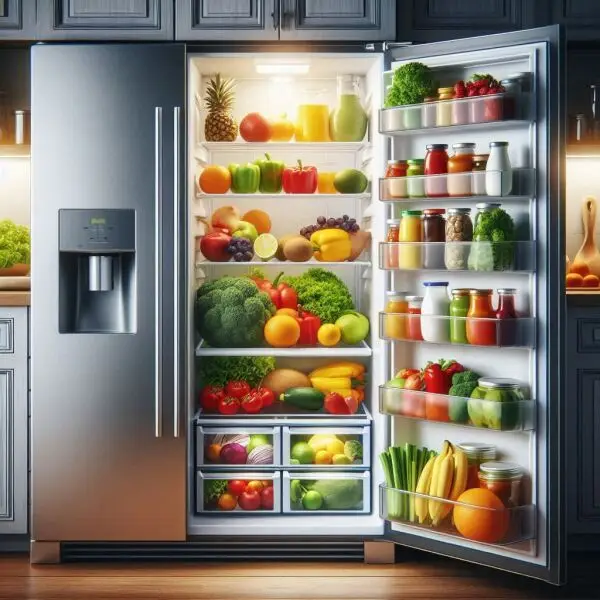5 Foods That Lose Quality in the Refrigerator and How to Preserve Them
Discover 5 foods that lose quality in the refrigerator and learn how to properly preserve them without refrigeration. Improve the taste and texture of your meals....
Table of Contents
- Refrigeration: A Not Always Suitable Approach
- Foods That Lose Quality in the Cold
- Storage Alternatives for Other Products
- Optimization of Refrigerator Use
Follow Patricia Alegsa on Pinterest!
Refrigeration: A Not Always Suitable Approach
Opening the refrigerator door and placing any food inside is a common practice, but not always the most appropriate. Although cold is effective in extending the shelf life of many products, not all foods benefit from refrigeration.
In fact, some may suffer changes in their flavor, texture, and freshness, as warned by food technology experts.
The key is to know which products should not be refrigerated and how to store them properly.
How often should you clean your home refrigerator?
How often should you clean your home refrigerator?
Foods That Lose Quality in the Cold
The bread, especially sliced bread, is a classic example of a food that does not benefit from refrigeration.
Instead of retaining its freshness, bread hardens and loses its characteristic flavor due to the moisture accumulated in the cold environment of the refrigerator.
To keep it in better condition, it is recommended to store it at room temperature, wrapped in paper or a clean cloth. If you want to prolong its shelf life, freezing is a more effective option.
Another product that suffers in the refrigerator is chocolate. The cold can alter the emulsification of the fats, causing it to take on a whitish color and a grainy texture.
Another product that suffers in the refrigerator is chocolate. The cold can alter the emulsification of the fats, causing it to take on a whitish color and a grainy texture.
To preserve its quality, it is ideal to keep it in a cool, dark place, at a stable temperature between 15 and 20 degrees Celsius, and in its original packaging or in an airtight container.
Garlic is another food that should not be refrigerated. When doing so, they tend to sprout, intensifying their bitter flavor. The best way to preserve garlic is in a cool place, around 15 degrees Celsius, and away from potatoes, as both emit gases that accelerate sprouting. For prolonged storage, they can be stored in olive oil or frozen.
Bananas, especially when they are green, also react poorly to cold. Refrigeration slows down their ripening, affecting their flavor and darkening their skin. For proper ripening, they should be stored at room temperature, away from apples, which emit ethylene and accelerate their ripening.
Foods that seem healthy, but are not
To ensure that food in the refrigerator remains in optimal condition, it is crucial to pay attention to its organization and storage. Separating raw foods from cooked ones is essential to prevent cross-contamination.
Storage Alternatives for Other Products
Garlic is another food that should not be refrigerated. When doing so, they tend to sprout, intensifying their bitter flavor. The best way to preserve garlic is in a cool place, around 15 degrees Celsius, and away from potatoes, as both emit gases that accelerate sprouting. For prolonged storage, they can be stored in olive oil or frozen.
Bananas, especially when they are green, also react poorly to cold. Refrigeration slows down their ripening, affecting their flavor and darkening their skin. For proper ripening, they should be stored at room temperature, away from apples, which emit ethylene and accelerate their ripening.
Foods that seem healthy, but are not
Optimization of Refrigerator Use
To ensure that food in the refrigerator remains in optimal condition, it is crucial to pay attention to its organization and storage. Separating raw foods from cooked ones is essential to prevent cross-contamination.
Cooked foods should be stored in closed containers on the upper shelves, while meats and fish should be placed on the bottom shelf, the coldest area of the refrigerator.
The bottom drawers are ideal for fruits and vegetables, protecting them from direct cold and maintaining their freshness. In the door of the refrigerator, the least cold area, it is better to store beverages, sauces, and condiments.
The bottom drawers are ideal for fruits and vegetables, protecting them from direct cold and maintaining their freshness. In the door of the refrigerator, the least cold area, it is better to store beverages, sauces, and condiments.
Maintaining an internal temperature between 3 and 5 degrees Celsius helps prevent the proliferation of bacteria and ensures better preservation of food. Additionally, regularly cleaning the refrigerator helps avoid bad odors and the accumulation of bacteria, ensuring a hygienic environment for food.
Subscribe to the free weekly horoscope
Aquarius Aries Cancer Capricorn Gemini Leo Libra Pisces Sagittarius Scorpio Taurus Virgo
-
 Ultra-processed Foods: Foods that Shorten Life and How to Achieve Longevity
Ultra-processed Foods: Foods that Shorten Life and How to Achieve Longevity
Discover how ultra-processed foods threaten your health and shorten life. Learn which foods to choose to live longer, according to Dr. Jorge Dotto. -
 Adult Acne: Causes, Treatments, and Effective Tips
Adult Acne: Causes, Treatments, and Effective Tips
Discover why acne affects adults, the most effective treatments, and expert advice to manage it successfully. Regain confidence in your skin! -
 5 Secrets of Lindsay Lohan for Her Skin to Shine Like This!
5 Secrets of Lindsay Lohan for Her Skin to Shine Like This!
Lindsay Lohan, at 38 years old, shines with renewed skin thanks to laser treatments, hydration, and hair care. Get inspired by her resurgence with these basic beauty tips. -
 Darkness as Healing: Benefits of the Absence of Light
Darkness as Healing: Benefits of the Absence of Light
Discover how the darkness of the sky improves your health: light pollution disrupts sleep and metabolism. -
 Make the most of the nutrients in fruit and vegetable peels
Make the most of the nutrients in fruit and vegetable peels
Discover how the nutrients in the outer parts of foods promote well-being and the optimal functioning of your body. Take care of your health!
I am Patricia Alegsa
I have been writing horoscope and self-help articles professionally for over 20 years.
Subscribe to the free weekly horoscope
Receive weekly in your email the horoscope and our new articles on love, family, work, dreams and more news. We do NOT send spam.
Astral and numerological analysis
-
 Discover your future, secret personality traits and how to improve in love, business and life in general
Discover your future, secret personality traits and how to improve in love, business and life in general
-
 Online Dream Interpreter: with artificial intelligence
Do you want to know what a dream you had means? Discover the power of understanding your dreams with our advanced online dream interpreter using artificial intelligence that responds to you in seconds.
Online Dream Interpreter: with artificial intelligence
Do you want to know what a dream you had means? Discover the power of understanding your dreams with our advanced online dream interpreter using artificial intelligence that responds to you in seconds.
-
 How Exercise Can Reduce Abdominal Fat: Revealing Results
How Exercise Can Reduce Abdominal Fat: Revealing Results
Discover how regular exercise transforms abdominal fat. Research reveals surprising results in people with obesity. Don't miss it! -
 Watch Out! Your makeup brushes might harbor more bacteria than a toilet
Watch Out! Your makeup brushes might harbor more bacteria than a toilet
Surprise! Makeup brushes can harbor more bacteria than a toilet. Make sure to clean those brushes thoroughly to avoid a germ party. -
 6 foods you should not heat in the microwave
6 foods you should not heat in the microwave
Discover the 6 foods you should never heat in the microwave and learn how to clean it to prevent accidents. Expert tips for safe use. -
 Fast vs. Slow Repetitions: The Key to Increasing Your Muscle Mass
Fast vs. Slow Repetitions: The Key to Increasing Your Muscle Mass
Fast or slow repetitions? Discover how the pace of your exercises influences muscle development and achieve your fitness goals faster. -
 Foreign Accent Syndrome: What Causes It and How It Affects Speech
Foreign Accent Syndrome: What Causes It and How It Affects Speech
Discover the enigmatic foreign accent syndrome: a rare disorder that reveals the intriguing connection between the brain and language. -
 The detox approach that celebrities use for a long life
The detox approach that celebrities use for a long life
Discover how to live longer and better with Alejandro Junger, the doctor of the stars. His detox approach combines nutrition, supplements, and healthy habits. -
 The relationship between poor sleep and lactose intolerance
The relationship between poor sleep and lactose intolerance
Yes! There is a relationship between sleeping poorly and having trouble digesting lactose, which is the sugar in milk. Find out how to solve this problem here. -
 This is the future you deserve
This is the future you deserve
To have the future you deserve, you must believe in reality. -
 Increase in Pancreatic Cancer in Young People: Symptoms and Prevention
Increase in Pancreatic Cancer in Young People: Symptoms and Prevention
Cases of pancreatic cancer are increasing in those under 50. Learn about symptoms and how to prevent it with lifestyle changes such as losing weight and reducing alcohol consumption. -
 Karmic Compatibility: How to Know if Your Partner Was with You in Past Lives
Karmic Compatibility: How to Know if Your Partner Was with You in Past Lives
Discover if you and your partner have a past life bond. Karmic astrology reveals hidden connections and compatibilities in your natal charts. -
 How Stress Affects Your Blood Pressure: Tips
How Stress Affects Your Blood Pressure: Tips
Discover how stress affects blood pressure and how managing daily tension can improve heart health. Expert tips included. -
 Why can't you follow a conversation? Regain your attention!
Why can't you follow a conversation? Regain your attention!
Discover why we lose attention in conversations and how multitasking and notifications affect our concentration. Regain your focus! -
 What does it mean to dream of shower curtains?
What does it mean to dream of shower curtains?
Discover the hidden meaning behind your shower curtain dreams - do you feel vulnerable or protected? Read our article and find out!